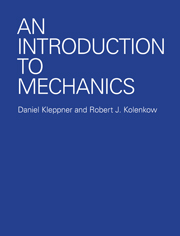Book contents
- Frontmatter
- Contents
- LIST OF EXAMPLES
- PREFACE
- TO THE TEACHER
- AN INTRODUCTION TO MECHANICS
- 1 VECTORS AND VECTORS KINEMATICS—A FEW MATHEMATICAL PRELIMINARIES
- 2 NEWTON'S LAWS—THE FOUNDATIONS OF NEWTONIAN MECHANICS
- 3 MOMENTUM
- 4 WORK AND ENERGY
- 5 SOME MATHEMATICAL ASPECTS OF FORCE AND ENERGY
- 6 ANGULAR MOMENTUM AND FIXED AXIS ROTATION
- 7 RIGID BODY MOTION AND THE CONSERVATION OF ANGULAR MOMENTUM
- 8 NONINERTIAL SYSTEMS AND FICTITIOUS FORCES
- 9 CENTRAL FORCE MOTION
- 10 THE HARMONIC OSCILLATOR
- 11 THE SPECIAL THEORY OF RELATIVITY
- 12 RELATIVISTIC KINEMATICS
- 13 RELATIVISTIC MOMENTUM AND ENERGY
- 14 FOUR VECTORS AND RELATIVISTIC INVARIANCE
- INDEX
13 - RELATIVISTIC MOMENTUM AND ENERGY
- Frontmatter
- Contents
- LIST OF EXAMPLES
- PREFACE
- TO THE TEACHER
- AN INTRODUCTION TO MECHANICS
- 1 VECTORS AND VECTORS KINEMATICS—A FEW MATHEMATICAL PRELIMINARIES
- 2 NEWTON'S LAWS—THE FOUNDATIONS OF NEWTONIAN MECHANICS
- 3 MOMENTUM
- 4 WORK AND ENERGY
- 5 SOME MATHEMATICAL ASPECTS OF FORCE AND ENERGY
- 6 ANGULAR MOMENTUM AND FIXED AXIS ROTATION
- 7 RIGID BODY MOTION AND THE CONSERVATION OF ANGULAR MOMENTUM
- 8 NONINERTIAL SYSTEMS AND FICTITIOUS FORCES
- 9 CENTRAL FORCE MOTION
- 10 THE HARMONIC OSCILLATOR
- 11 THE SPECIAL THEORY OF RELATIVITY
- 12 RELATIVISTIC KINEMATICS
- 13 RELATIVISTIC MOMENTUM AND ENERGY
- 14 FOUR VECTORS AND RELATIVISTIC INVARIANCE
- INDEX
Summary
Momentum
In the last chapter we saw how the postulates of special relativity lead in a natural way to kinematical relations which agree with newtonian relations at low velocity but depart markedly for velocities approaching c. We turn now to the problem of investigating the implications of special relativity for dynamics. One approach would be to develop a formal procedure for writing the laws of physics in a form which satisfies the postulates of special relativity. Such a procedure is actually possible; it involves the concepts of four-vectors and relativistic invariance, and we shall pursue it in the next chapter. However, here we shall take another approach, one which is not as powerful or as economical as the method of four-vectors, but which has the advantage of using physical arguments to show the relation between the familiar concepts of classical mechanics and their relativistic counterparts.
First we shall focus on conservation of momentum and find what modifications are needed to preserve this principle in relativistic mechanics. This is a technique often used in extending the frontiers of physics: by reformulating conservation laws so that they are preserved in new situations, we are quite naturally led to generalizations of familiar concepts. In particular, as the following argument shows, we must modify our idea of mass to preserve conservation of momentum under relativistic transformations.
- Type
- Chapter
- Information
- An Introduction to Mechanics , pp. 489 - 514Publisher: Cambridge University PressPrint publication year: 2010

